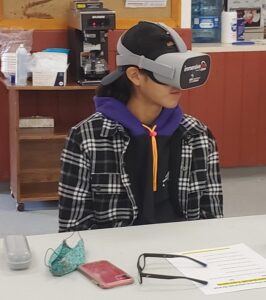ORIGIN expands immersive cultural library to include virtual reality experiences

By Rick Garrick
THUNDER BAY — ORIGIN is adding a variety of virtual reality (VR) Indigenous cultural experiences to its ImmersiveLink library of 360-degree VR videos designed to bring careers, cultures, workplaces and communities to life.
“We decided to go ahead and produce cultural experiences inviting as many knowledge keepers across Canada as possible to share their stories and to help support reconciliation,” says Melissa Hardy-Giles, owner at ORIGIN and Red Rock Indian Band citizen. “We now have our cultural library so whoever has a subscription to our career library will automatically get their subscription to our cultural library.”
Hardy-Giles says ORIGIN launched the VR cultural experiences to provide information about Indigenous cultures through its ImmersiveLink library service, which is being used by more than 1,000 schools across the country.
“Our outreach with our career experiences was so vast that we knew it was a perfect opportunity to educate Canadians on our Indigenous culture,” Hardy-Giles says. “Even myself, an Indigenous person from [Red Rock Indian Band], I’m learning a lot about our culture from our knowledge keepers because it is so diverse and there are so many knowledge keepers out there.”
Hardy-Giles says the VR cultural experiences are also being used by industry and employers to provide staff with additional information along with their cultural awareness training.
“It’s not the conventional check-the-box fare — it’s an actual experience, it brings you right into the situation,” Hardy-Giles says. “It teaches everyone different aspects of our culture.”
Hardy-Giles says people are usually surprised when they view the ImmersiveLink experiences through the headsets.
“Everyone thinks they know what the experience is going to be like but you don’t get it until you try it,” Hardy-Giles says. “You’re so immersed into the situation and the story, you feel a part of it.”
Hardy-Giles says ORIGIN is currently creating VR cultural experiences with knowledge keepers from northwestern Ontario but they are also reaching out to knowledge keepers across the country who are interested in participating.
“We, first of all, sit with the knowledge keeper and discuss exactly they want to share [and] what the protocols are around the particular teaching because we want to be as respectful as possible,” Hardy-Giles says, noting they then do a storyboarding session and make sure everyone is comfortable with the process before beginning to shoot the VR video with a 360-degree camera and a crew of about four-to-five people. “It’s a camera that you can see all around you, so you can see behind you, you can look up to the sky and down below. That’s why we named the system ImmersiveLink because you’re literally immersed into the experience. You feel like you are there, you’re not watching a flat-screen listening to stories. You actually feel like you are sitting [with the knowledge keeper] listening to a story, so it’s as close to being there as possible.”
Hardy-Giles says the knowledge keepers are provided with an opportunity to view the video before it is posted in the ImmersiveLink library.
“We make sure the knowledge keeper and ourselves are happy with the product before we load it up into our cultural library,” Hardy-Giles says.
Hardy-Giles adds that all of the ImmersiveLink subscribers receive a notification whenever a new VR cultural experience is added to the ImmersiveLink library.
Information about ORIGIN’s ImmersiveLink library is posted online.
ORIGIN began using VR technology for workforce readiness tools in 2018.


